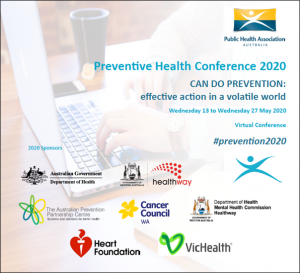Australia’s first virtual Preventive Health Conference
June 23, 2020
This blog was contributed by Kate Wingrove and Emily Denniss. Both PhD candidates were awarded VicHealth scholarships to attend the Public Health Association of Australia’s first virtual Preventive Health Conference.
Effective action in a volatile world
The Public Health Association of Australia hosts a range of conferences and events that bring public health professionals, policy-makers, and researchers together. The Preventive Health Conference has been running annually since 2018. In 2020, the first virtual Preventive Health Conference was held from May 13-27. The conference theme ‘CAN DO PREVENTION: effective action in a volatile world’ was particularly fitting in the time of COVID-19. We were pleased to attend this conference from home at the last minute, with financial support from VicHealth. In this blog post, we share some of the take-home messages from the event and reflect on the pros and cons of attending a virtual conference.
Learning from the COVID-19 response in Australia

Conference program for PHAA’s virtual conference
Many presenters discussed the positive aspects of the COVID-19 response in Australia. The public health response has given the general public a greater understanding of what public health is and why prevention is important. It has also demonstrated that huge gains are possible in a short amount of time, for example, the upscaling of telehealth. Telehealth is the remote delivery of health services via phone or video call and its rapid expansion enabled Australians in remote, rural and urban areas to communicate with healthcare providers, contact-free. Australia’s response to COVID-19 has also demonstrated that the approaches public health experts have been advocating for, for many other important public health issues, can work. Evidence-based, systems-based, and collaborative approaches, involving a range of experts, have contributed to preventing the spread of COVID-19 in Australia. The success of these approaches and Australia’s response to COVID-19 is encouraging for Australia’s public health system more broadly and shows what’s possible when there is a united effort to tackle a public health issue.
Evidence use in policy-making
As researchers, we want our work to have a positive impact on public health. An important message from Dr Sandro Demaio (CEO of VicHealth), was that publishing results in scientific journals isn’t enough. If we want our research to have an impact, we need to make it accessible to a wider audience. For example, results of the EAT-Lancet Commission on healthy diets from sustainable food systems were published in the Lancet, and in a summary report that used infographics and photographs to convey key messages. If we want our research to be used by policy-makers, we also need to keep some political realities in mind. Dr Nick Watts (Executive Director, Lancet Countdown on Health and Climate Change) used compelling evidence to demonstrate that climate change is a health issue, and that the response to climate change is now entirely a political question. The Hon Chris Bowen MP (Shadow Minister for Health) called for an evidence-based response to climate change but cited a lack of political support in the Coalition party room as a barrier to policy implementation. We know that politicians want our votes, so one way to increase political support for action on public health is to increase public support for these issues.
Health communication and message framing
The importance of health communication and strategically framing health messages was another take-home message from the conference. Effective communication of health information and research to the public is critical for preventative health. Conference presenters consistently mentioned that a range of approaches are needed for effective health communication. One approach is being strategic about the way health messages are framed. Communicating health information to the public in a relevant and understandable way means that the important messages are more likely to have an impact. Dr Demaio gave the example of celebrating food through the Festival21 food festival. This event was used to communicate information about sustainable food production and consumption, nutrition and disease prevention. Pat Turner (CEO, National Aboriginal Community Controlled Health Organisation) spoke about the use of adapted COVID-19 social distancing messaging to suit the needs of Aboriginal communities. Staying “one shopping trolley’s distance away”, was a simple but effective change to communicate important information about social distancing.
Pros and cons of a virtual conference
A major advantage for us was that the virtual format allowed us to attend a conference that we wouldn’t have otherwise been able to attend. In the future, virtual conferences may allow a wider range of people to participate, including those who don’t have the capacity to travel. On a global scale, reduced conference-related travel may also have positive environmental impacts. The combination of live plenary sessions and pre-recorded presentations meant we could work our way through the content at our leisure, while still having the opportunity to engage with keynote speakers in real time. However, we sometimes found it difficult to balance conference attendance with other work-related commitments. Another disadvantage was the lack of face-to-face networking opportunities. However, the virtual networking ‘afternoon tea’ ran smoothly, and as we all become more comfortable with online communication, virtual networking may become the new normal. Overall, our virtual conference experience was a very valuable one. Thank you to everyone involved.